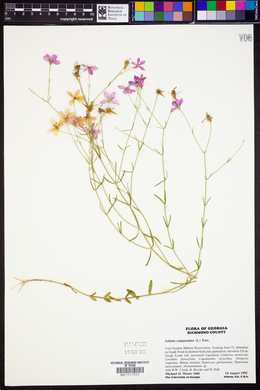Sabatia campanulata
|
|
|
|
Family: Gentianaceae
Slender Rose-Gentian
|
Perennial herb 15 - 60 cm tall Leaves: opposite, stalkless (but not clasping), 2 - 4 cm long, somewhat thickened and slightly rolled under at the edges, non-toothed, three-nerved, but mostly with only the midvein obviously raised on the underside. The leaf blades are widest below the middle, but going up the stem the shape changes, with the lower leaves being oblong or lance-shaped, and the upper leaves being very narrow and linear. Flowers: rose, pale crimson, or pink (rarely white), radially symmetric, 1.8 - 3.4 cm wide, and solitary on slender, wiry, slightly angled, 2 - 9 cm long stalks at the end of slender, alternate branches. Sepals: five, but fused at base into a papery or membranous, 1 - 3 mm tall (about as tall as broad), inversely conic tube. The separate sepal lobes are 7 - 20 mm long, firm, linear, bristle-like, and often less than 0.5 mm wide. Petals: five, but fused at very base into a cylindric tube, which is two to three times longer than the sepal tube, then separating into much longer, 1 - 2 cm long, oblong or elliptic, spreading lobes. The petal lobes have 2 - 3 mm long, egg-shaped yellow spots at their bases, which are often bordered by an irregular red line, but no glands are present. Stamens: five, with pale yellow, 2 - 4 mm long (usually shorter than anthers), slender filaments ending in bright yellow, 2 - 5 mm long, slender anthers. Pistil: with a single-chambered, superior ovary; a green to greenish-yellow, 2 - 5 mm long, style, which is cleft to about its middle and shorter than the two, 3 - 7 mm long, pale green or yellowish stigma lobes. Fruit: a many-seeded, single-chambered, 5 - 7 mm long, 2.5 - 4 mm wide, cylindric capsule. Stems: usually several, alternately branched in the upper half, slender, hollow below, round in cross-section but sometimes with some ridges on the angles. Root system: of a short, 1 - 4 cm long, branched, woody, central underground "stem" with slender, succulent roots descending from its base for up to 10 cm. Similar species: Sabatia campanulata is very similar to S. campestris (though it is now believed extinct in our area), but that species is an annual that has a noticeably angled stem, clasping leaves, and longer fused sepal tubes with very strong wings or ridges running up the outer sides. Also similar is S. angularis, but it is an annual or biennial, which differs by having basal rosette leaves, evident wings on the stem angles, clasping leaves, opposite inflorescence branches, and a shallow fused sepal tube with small ridges at the very base. Flowering: July to September Habitat and ecology: Only found at a single site in the Chicago Region in Jasper County, Indiana, requiring moist or wet habitats such as damp sands and peat. This is a species of the Atlantic Coastal Plain with very few local inland populations. Occurence in the Chicago region: native Notes: The distribution for this species is centered in the Atlantic Coastal Plain, as are most species of the genus Sabatia. There are a very few local sites for this species in Kentucky and Indiana, with the one site from the Chicago Region being the farthest north outlier (see Wilbur 1955). The only record of this species in the Chicago Region, in Jasper County, Indiana, is from a single collection from 1940 that is housed in the Gray Herbarium at Harvard University. Etymology: Sabatia is named after Liberato Sabbati, an Italian botanist from the mid-1700's. Campanulata is the Latin word for bell-shaped. Author: The Field Museum Perennial from a short branched caudex, slender, 2-6 dm, simple to freely and divaricately branched; lvs of the main axis below the branches oblong or lance-oblong, 2-4 cm, obtuse, widest actually or apparently below the middle, rounded to a sessile base, 3-nerved; upper lvs much narrower; cal-tube inconspicuously 10-nerved, the lobes linear, 7-15 (avg 13) mm; cor pink (white) with a yellow eye, the lobes oblanceolate, 10-15 mm, averaging less than half as wide; style usually cleft to slightly below the middle. Moist or wet places on the coastal plain from Mass. to n. Fla. and w. to La. and Ark., locally inland to Ky., Ind., and Ill. July, Aug. (S. gracilis) Gleason, Henry A. & Cronquist, Arthur J. 1991. Manual of vascular plants of northeastern United States and adjacent Canada. lxxv + 910 pp. ©The New York Botanical Garden. All rights reserved. Used by permission. From Flora of Indiana (1940) by Charles C. Deam Our only specimens were found in a small colony in rather acid soil in a low, sandy flat in a woods 4 miles north of Washington, Daviess County. Here it was closely associated with Betula nigra, Spiraea tomentosa, Viola lanceolata, Viola sagittata, Rhexia mariana var. leiosperma, Rhexia virginica, Linum medium var. texanum, and Hieracium gronovii. …… Indiana Coefficient of Conservatism: C = 10 Wetland Indicator Status: FACW |
|
|
|





































































